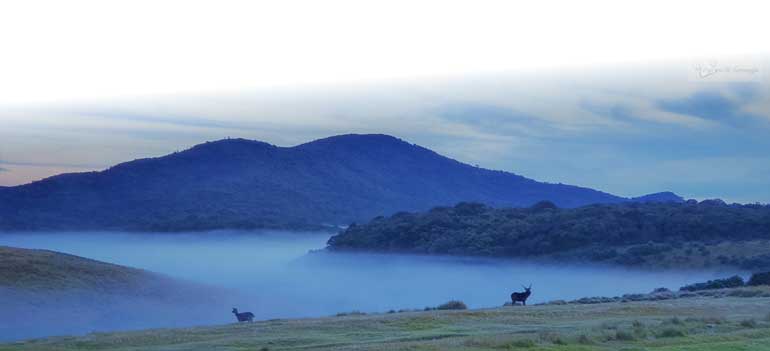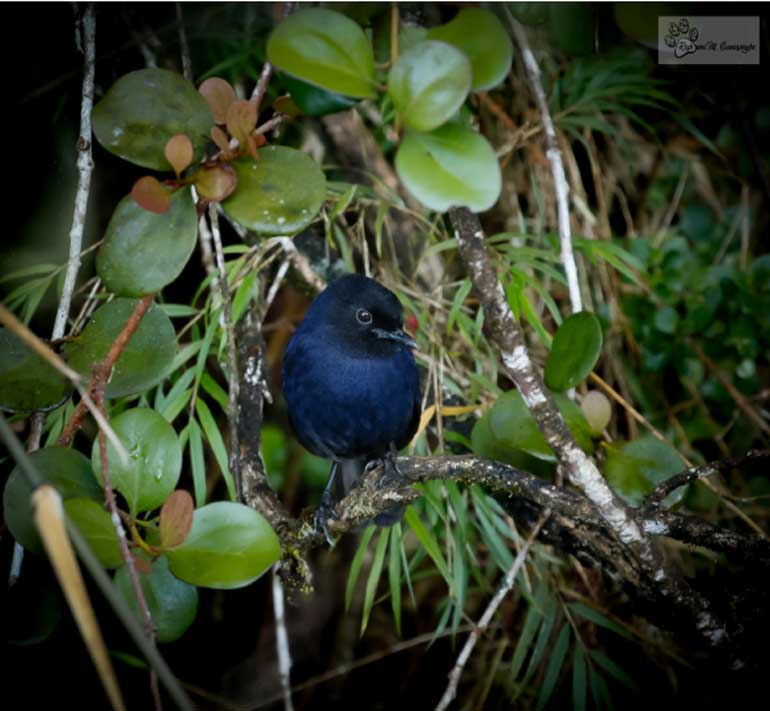Saturday Dec 14, 2024
Saturday Dec 14, 2024
Saturday, 12 June 2021 00:05 - - {{hitsCtrl.values.hits}}

By Shailendree Wickrama Adittiya
|
Dr. Rohan Pethiyagoda
|
Conversations on conservation are extremely crucial, especially in a country like Sri Lanka, but many would argue that a sufficient number of conversations with the right persons do not take place. What does take place must be fuelled not by a gut instinct for what the environment needs and what must be done to conserve our wildlife resources, nor should it have a political agenda.
What is needed is a scientific approach backed by data.
This was the topic of discussion at the monthly lecture organised by the Wildlife and Nature Protection Society (WNPS) in May, with Dr. Rohan Pethiyagoda exploring the topic ‘Conserving Horton Plains: What the Science Tells Us’.
The speaker is a biodiversity scientist and has published over 60 research papers. He has also authored several books on Sri Lanka’s fauna and flora through the Wildlife Heritage Trust (WHT). Dr. Pethiyagoda argued that public policy must be built on the basis of science and values should be guided by science.
“In every area of environmental controversy, we have to remember that if we follow the science, we do ourselves a huge favour. If we follow our gut or our political preferences, we do the whole community an enormous disservice,” Dr. Pethiyagoda said.
However, there is a lack of data and research that can be studied when building policy or deciding on the best approach for conservation. This is due to the fact that Sri Lanka does not have a large community of researchers for this line of work, Dr. Pethiyagoda said, adding that this was why Sri Lanka needed a wildlife or biodiversity research institute.
Research institution
“We are one of the few countries in the world that does not have a wildlife institution,” he said, but it is not that attempts have not been made.
An effort was made in 2003 to establish a National Institute of Biodiversity and Dr. Pethiyagoda played a key role in these efforts. Funding would come from donors across the world and there was $ 22 million in pledges. One-fourth of this would go into the physical infrastructure of the institute and the remaining three-fourths would go into a perpetual endowment fund outside Sri Lanka.
The estimated 10% annual earnings from the fund would be used to offer grants to Sri Lanka’s research community.
However, a public campaign was launched by certain environmental and nature protection organisations in Sri Lanka, putting a stop to what could have been a well-funded National Institute of Biodiversity. The funding went to India, which now has two biodiversity institutions.
The incident was brought up by Dr. Pethiyagoda not only because of his involvement in the project but because the country must learn to not make such mistakes, especially such expensive mistakes.
While the need for a research institute was recognised, the need for conversation too, was emphasised during the WNPS lecture. The obvious place for conversation would be the Wildlife Conservation Department (DWC).
“The obvious place for the conversation to take place is the Wildlife Department, and for that, there is the Fauna and Flora Advisory Committee. I think that committee has not been made a pivot often enough,” Dr. Pethiyagoda said, adding that the Advisory Committee is usually under pressure because committees have political appointees.
Politics at play
While the involvement of politicians and persons with political backing can be a step back in the efforts made towards conservation, Dr. Pethiyagoda also touched on the political differences within the conservation community itself.
Addressing the topic of management of visitors, Dr. Pethiyagoda explained that some see visitors as an opportunity, which others see visitors as a threat.
“We have got almost a political divide between the two groups of people and we rarely have a conversation. I acknowledge that too many visitors are the problem for Horton Plains. For example, they lead to a lot of road deaths because they have got tens and thousands of vehicles coming into Horton Plains every year,” he said.
However, solutions must look at addressing these problems while sustaining the visitors. Dr. Pethiyagoda suggests a good visitor centre catering to a wide range of interests, a cable car system on the World’s End side of Horton Plains, and a good shuttle service using electric vehicles from Ohiya or Pattipola.
There is also a divide when it comes to herbicide and the use of it in efforts to remove alien or invasive species from places like Horton Plains. While saying the use of herbicide in Horton Plains may not be that popular, Dr. Pethiyagoda explained that it could be beneficial when removing gorse in Horton Plains, which were introduced by the British 100 years ago, but has lately become an invasive species.
He explained that gorse leaves a large amount of seeds behind, which can remain in the soil for up to 30 years. In addition to this, the bare earth that remains after invasive species like gorse is removed seems to become home to other alien species as opposed to native Sri Lankan species.
Thus the solution is not merely to uproot and destroy the gorse.
“If you use an herbicide in a controlled way, it can be very effective,” Dr. Pethiyagoda said, explaining that cutting off the gorse at the level of the ground, damaging the stump, spraying a little herbicide in it, and closing it up for a few months will damage the stump and the root of the plants.
This method was tested in New Zealand and found to be successful.
While the use of herbicide can be effective in this instance, it is not always the best method. This applies to efforts to remove alien grass species that have an advantage over rainforest grass as they are used to direct sunlight.
Horton Plains has two different kinds of grassland. One is the result of the potato cultivation that took place on around 1,000 acres of the ground in the 1960s and was fertilised using cattle manure.
The manure contained seeds of grass brought to Sri Lanka to be used as pasture grass. “These grasses were much more aggressive than native grasses in Horton Plains, so we have 1,000 acres of pasture grass that is not native to Horton Plains,” he said.
The rest of Horton Plains has native grasses, but where new grass grew after burning in the past, alien species now grow. In Horton Plains, the alien species are often those brought to the country for horticulture.
Since herbicide is not an option in this instance, shade netting can be used to repress alien species. However, shade netting has a terrible appearance, which is why it must be balanced with the tourism industry in mind.
Canopy dieback
Canopy dieback was also an area of focus in the lecture delivered by Dr. Pethiyagoda. He explained that Horton Plains is known as a tropical mountain cloud forest, which means that for much of the time the cloud level is low enough to touch the ground and the vegetation.
“Many of the trees in Horton Plains that reach the canopy have leaves that are specialised. They are called sclerophyll leaves that are specialised in having mist water condensed on them, they are waxy on their surface, and the mist water condense then drips off to the forest floor. So in addition to rainfall, this vegetation is specialised in capturing mist water,” he explained.
Since Horton Plains does not receive a lot of rain, mist water becomes extremely relevant. However, cloud table rises when a tropical mountain cloud forest is surrounded by deforested area and this is backed by studies carried out in Costa Rica. This is, unfortunately, the case in Horton Plains, which is surrounded by tea plantations and grassland for cattle farms.
“This means that there is less mist passing through the canopy and therefore less mist being absorbed by the vegetation. So that too, could add to hydrological stress to the plants. That, in turn, may contribute to the phenomenon of canopy dieback,” Dr. Pethiyagoda explained.
He went on to say that studies also showed that the mist passing through Horton Plains was highly acidic, enough to cause acid damage to foliage. Due to its smaller size and larger surface area, mist water can absorb more pollutants than rain water. “But we have never measured or monitored the quality of air on Horton Plains. As a result of that, we have no idea what pollutants are passing through,” he added.
Heavy metals are also an area of stress and Dr. Pethiyagoda said a 2015 study showed that a high level of lead in the soil. When lead exceeds a certain level, dieback occurs.
“We do not know where this lead is coming from because we do not have monitoring studies, but this is a part of the research that needs to get done. We do not have lead in petrol, of course, because the Ceylon Petroleum Corporation since 2003 stopped adding lead to our petrol,” he said, adding that he played a key role in this as well.
Studies also found that adding compost reduced the dieback, but Dr. Pethiyagoda raised concerns about this as Horton Plains is a large area and it is not known if compost will address the issue in the long term.
There are thus several contributing factors to canopy dieback, including heavy metal pollution, longer dry period, rising temperature, loss of epiphytes, acid mist or rain, higher cloud table, depleted soils, and higher wind speed. These factors also interact with each other in ways we do not yet understand, Dr. Pethiyagoda said, stressing that even the best brains in the country cannot do anything about it because we do not have the necessary data.
Need for monitoring
“We need to have extensive monitoring on places like Horton Plains. That is the first intervention we need to put in place. We have just started measuring climate and logging climate data,” Dr. Pethiyagoda said, adding that we also need to look at air quality, rain water quality, mist water quality and soil quality across the matrix even in this very small national park.
On a more positive note, Dr. Pethiyagoda said that preliminary studies suggest that forest cover is increasing. These studies show that forest cover went from 72% to 78% while grass cover went from 28% to 24% between 1998 and 2008.
“When we look at restoration, we are at the cusp of a project that the Wildlife Detent is in the very early stages of right now,” Dr. Pethiyagoda said.
He was referring to the 700 hectares of tea, known as the Udaweriya Estate, the Wildlife Conservation Department has taken over from the Land Reform Commission. This would increase the Horton Plains area by 20% and natural forest will be restored in this area.
“This is, to my mind, the most ambitious conservation project that has been undertaken in Sri Lanka up to now, because this is terrible land to work with,” he said, explaining that the land is steep, prone to landslides, and has alien species like acacia and eucalypts growing on it.
The project will cost billions of rupees, need intensive management, and will take decades.
Pix courtesy Dr. Rishani M. Gunasinghe




